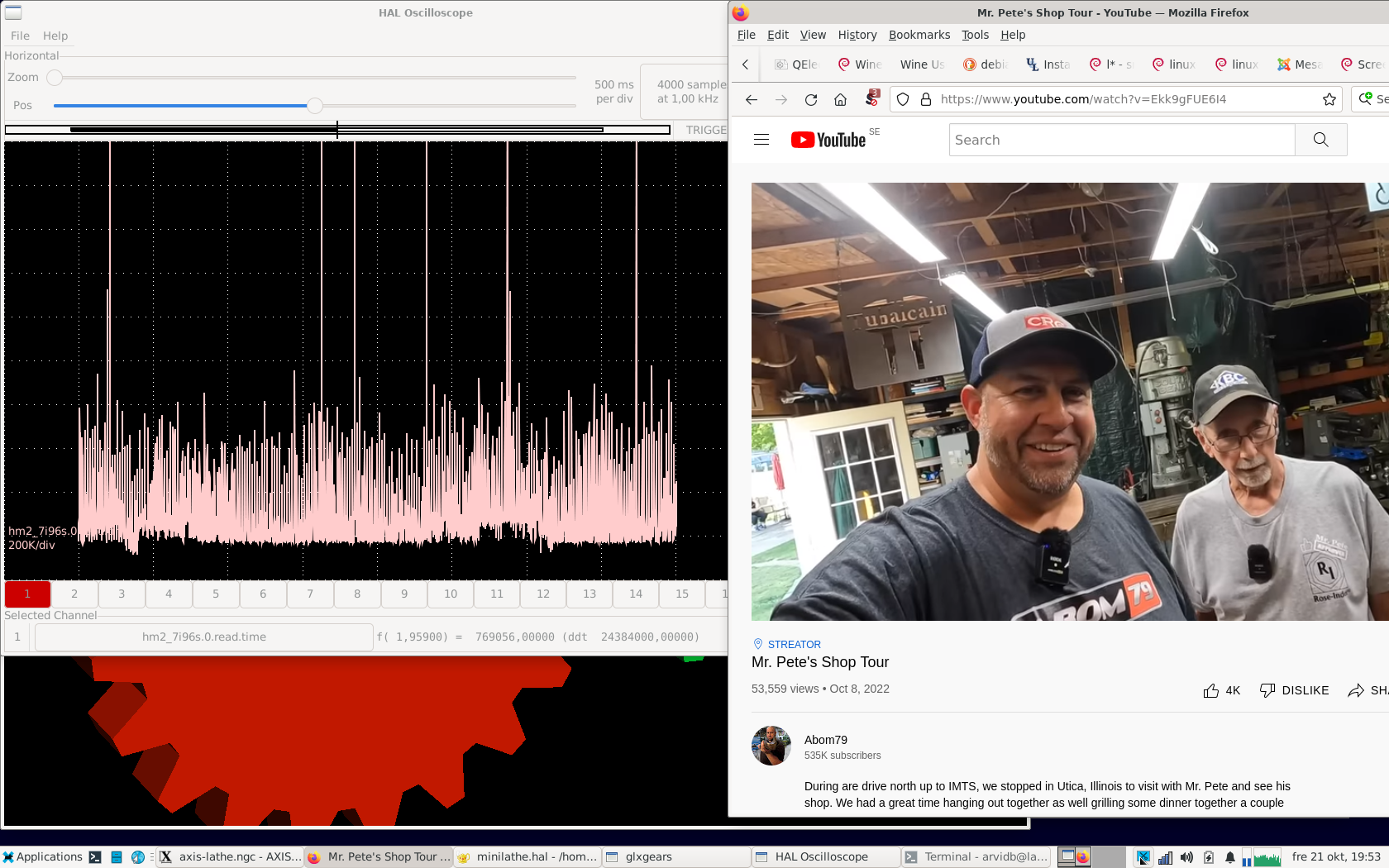Mesa hm2/hm2_7i96s.0: error finishing read
- PCW
-

- Offline
- Moderator
-

- Posts: 17441
- Thank you received: 5088
1. AMT disabled in the BIOS
2. IRQ coalescing disabled
Please Log in or Create an account to join the conversation.
- arvidb
-

- Offline
- Platinum Member
-

- Posts: 459
- Thank you received: 157
Computer: Lenovo Thinkcentre M710q Tiny i3-7100T
$ sudo ethtool --show-coalesce enp0s31f6
Coalesce parameters for enp0s31f6:
Adaptive RX: n/a TX: n/a
stats-block-usecs: n/a
sample-interval: n/a
pkt-rate-low: n/a
pkt-rate-high: n/a
rx-usecs: 0
...
$ sudo ethtool -i enp0s31f6
driver: e1000e
version: 5.10.0-18-rt-amd64
firmware-version: 0.8-4
expansion-rom-version:
bus-info: 0000:00:1f.6
...BIOS:
EIST, hyperthreading, virtualization disabled
Everything under Advanced->Intel Manageability disabled
Only C1 enabled (but enabling C1E and C3 as well makes no difference)
Running 5.10 kernel:
$ uname -a
Linux lathe 5.10.0-18-rt-amd64 #1 SMP PREEMPT_RT Debian 5.10.140-1 (2022-09-02) x86_64 GNU/LinuxWith 1 glxgears and one YT video running I get "hm2/hm2_7i96s.0: Smart Serial port 0: DoIt not cleared from previous servo thread" and/or the error finishing read almost instantly - in fact this screenshot was a bit tricky to get since things fail so fast:
Same test but with 4.19 kernel:
$ uname -a
Linux lathe 4.19.0-22-rt-amd64 #1 SMP PREEMPT RT Debian 4.19.260-1 (2022-09-29) x86_64 GNU/LinuxHere I don't get any DoIt or error finishing read messages during the minutes I had it running.
Attachments:
Please Log in or Create an account to join the conversation.
- arvidb
-

- Offline
- Platinum Member
-

- Posts: 459
- Thank you received: 157
Looking into /var/log/Xorg.0.log I find this info about my graphics card (and driver?):
(II) modeset(0): glamor X acceleration enabled on Mesa Intel(R) HD Graphics 630 (KBL GT2)
Please Log in or Create an account to join the conversation.
- PCW
-

- Offline
- Moderator
-

- Posts: 17441
- Thank you received: 5088
That's why I was asking about bensttech's 8300,
as it seems possible to run 5.X kernels without these huge
latency spikes. That is, what is the difference between my
8300 and bensstechs?
Please Log in or Create an account to join the conversation.
- arvidb
-

- Offline
- Platinum Member
-

- Posts: 459
- Thank you received: 157
Please Log in or Create an account to join the conversation.
- rodw
-

- Offline
- Platinum Member
-

- Posts: 11526
- Thank you received: 3860
I don't know. This article says otherwise.I doubt it will become standard, ever, as it has to stop plenty of functions used for power saving, and since the era of PC domination is over, laptops and tablets rule now.
Using Preempt-RT on laptops a lot, so i know they use much more power and heat a lot more with it. On most when RT is in use running LinuxCNC the processor will remain at max speed (not turbo) all the time.
www.phoronix.com/news/520-Maybe-Real-Time-PREEMPT_RT
Progress was slowed due to lack of funds, but Intel bought the main developer so there is progress again... and the number of patches are steadilly diminishing as the code is pushet to the main line kernel. Its very close.
Please Log in or Create an account to join the conversation.
- rodw
-

- Offline
- Platinum Member
-

- Posts: 11526
- Thank you received: 3860
When I looked around for a used 8300, there were two types. Conventional desktop and an All in one. I wonder if that is the difference?Right, but 5.10 works OK on my 8300
That's why I was asking about bensttech's 8300,
as it seems possible to run 5.X kernels without these huge
latency spikes. That is, what is the difference between my
8300 and bensstechs?
Please Log in or Create an account to join the conversation.
- tommylight
-

- Away
- Moderator
-

- Posts: 20985
- Thank you received: 7155
At one point in time, intel had 14 of the "same" chipset with the same model number but different letters at the end, differences being in bus speed (back then normal), to power consumption (this is still very relevant), built in raid, 2 or 4 or 6 sata, usb 2/3 ports, etc etc.
Slowly but surely forgetting all that cr@p Intel did.
They did good things too, they pushed the power saving on Linux forward as it was terrible 20 years ago, they pushed the "boot in under 10 seconds" from a bloody CD rom, etc.
short version:
same model = not same performance for some things
Please Log in or Create an account to join the conversation.
- JPL
- Offline
- Platinum Member
-

- Posts: 337
- Thank you received: 118
When I looked around for a used 8300, there were two types. Conventional desktop and an All in one. I wonder if that is the difference?
Well, actually there are 5 types: All-in -one with touch, All-in one without touch. Desktop 'tower', Slim desktop, and ultra slim (USDT). There's actually quite a bit of difference between the USDT and the desktops. Then there's also many possible microprocessors that can be used for any of those.
(Gee, Tommy beat me to it...)
Please Log in or Create an account to join the conversation.
- tommylight
-

- Away
- Moderator
-

- Posts: 20985
- Thank you received: 7155
Please Log in or Create an account to join the conversation.


